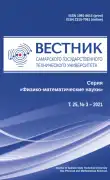On the place of sonic points in a critical flow
- Authors: Besportochny A.I.1, Burmistrov A.N.1
-
Affiliations:
- Moscow Institute of Physics and Technology (National Research University)
- Issue: Vol 25, No 3 (2021)
- Pages: 519-530
- Section: Mathematical Modeling, Numerical Methods and Software Complexes
- URL: https://journal-vniispk.ru/1991-8615/article/view/64194
- DOI: https://doi.org/10.14498/vsgtu1856
- ID: 64194
Cite item
Full Text
Abstract
Stationary irrotational barotropic gas flows are investigated on the basis of the analysis of three-dimensional Euler equations. Critical flows in the article are those in which the Mach number is everywhere less than or equal to one, and at least at one point the Mach number reaches one. In 1954, D. Gilbarg and M. Shiffman showed that if an internal (not lying on the streamlined surface) sonic point exists in a critical flow, then it lies on a flat sonic surface, which at all its points is perpendicular to the gas velocity vector and cannot end inside the flow (theorem about the sonic point). Using this theorem, D. Gilbarg and M. Shiffman obtained a conclusion that is important for the problems of maximizing the critical Mach number. It consists in the fact that in a critical flow for a wide class of bodies in flow, sonic points can be located only on its surface. This conclusion is essentially used in constructing the shapes of streamlined bodies with the maximum value of the critical Mach number (for given isoperimetric conditions).
In this paper, the question of the curvature of streamlines at the internal sonic points of critical flows is considered. It is shown that this curvature is zero. The result is a new necessary condition for the existence of an interior sonic point (and sonic surface). It consists in the fact that at the point of intersection with the sonic surface, the normal curvature of the streamlined surface in the direction normal to the sonic surface should be equal to zero. Examples of streamlined bodies are given for which the theorem by D. Gilbarg and M. Shiffman (on the sonic point) does not answer the question of the location of the sonic points, at the same time a new necessary condition makes it possible to prove that the existence of internal sonic points in a critical flow around these bodies is impossible.
Full Text
##article.viewOnOriginalSite##About the authors
Aleksandr I. Besportochny
Moscow Institute of Physics and Technology (National Research University)
Email: Alex1965-10@yandex.ru
ORCID iD: 0000-0002-1677-4604
Scopus Author ID: 57406584600
http://www.mathnet.ru/person171775
Cand. Phys. & Math. Sci.; Associate Professor; Dept. of Higher Mathematics
9, Institutskiy per., Dolgoprudny, Moscow region, 141701, Russian FederationAlexandr N. Burmistrov
Moscow Institute of Physics and Technology (National Research University)
Author for correspondence.
Email: a.burmistrov1@gmail.com
ORCID iD: 0000-0003-3862-7936
Scopus Author ID: 57406496700
http://www.mathnet.ru/rus/person177742
Cand. Phys. & Math. Sci.; Associate Professor; Dept. of Higher Mathematics
9, Institutskiy per., Dolgoprudny, Moscow region, 141701, Russian FederationReferences
- Petrov K. P. Aerodinamika elementov letatel’nykh apparatov [Aerodynamics of Aircraft Components]. Moscow, Mashinostroenie, 1985, 272 pp. (In Russian)
- Gilbarg D., Shiffman M. On bodies achieving extreme value of the critical Mach number. I, Indiana Univ. Math. J., 1954, vol. 3, no. 2, pp. 209–230. https://doi.org/10.1512/iumj.1954.3.53010
- Brutyan M. A., Lyapunov S. V. Optimization of the shape of symmetric plane bodies with the aim to increase the critical Mach number, Uchen. Zap. TsAGI, 1981, vol. 12, no. 5, pp. 10–22 (In Russian).
- Vyshinsky V. V. Influence of the elongation of the cylindrical section on the drag of the fuselage at transonic flight speeds, Uchen. Zap. TsAGI, 1985, vol. 16, no. 3, pp. 110–113 (In Russian).
- Kraiko A. N. Planar and axially symmetric configurations which are circumvented with the maximum critical Mach number, J. Appl. Math. Mech., 1987, vol. 51, no. 6, pp. 723–730. https://doi.org/10.1016/0021-8928(87)90131-6
- Vyshinsky V. V., Kuznetsov E. N. Investigation of bow parts of bodies of revolution with the Ryabushinsky generatrix, Uchen Zap. TsAGI, 1992, vol. 23, no. 1, pp. 3–8 (In Russian).
- Barinov V. A., Bolsunovsky A. L., Buzoverya N. P., Kuznetsov E. N., Skomorokhov S. I., Chernyshev I. L. Study on the model of the near-sonic aircraft with the Ryabushinsky nose part of the fuselage, Dokl. Phys., 2007, vol. 52, no. 4, pp. 553–555. https://doi.org/10.1134/S1028335807100102
- Sizykh G. B. Entropy value on the surface of a non-symmetric convex bow part of a body in the supersonic flow, Fluid Dyn., 2019, vol. 54, pp. 907–911. https://doi.org/10.1134/S0015462819070139
- Petrov A. G., Yudin M. A. On cylinder dynamics in bounded ideal fluid flow with constant vorticity, Fluid Dyn., 2019, vol. 54, no. 7, pp. 898–906. https://doi.org/10.1134/S0015462819070127
- Sizykh G. B. System of orthogonal curvilinear coordinates on the isentropic surface behind a detached bow shock wave, Fluid Dyn., 2020, vol. 55, no. 7, pp. 899–903. https://doi.org/10.1134/S0015462820070095
- Mironyuk I. Yu., Usov L. A. The invariant of stagnation streamline for a stationary vortex flow of an ideal incompressible fluid around a body, Vestn. Samar. Gos. Tekhn. Univ., Ser. Fiz.-Mat. Nauki [J. Samara State Tech. Univ., Ser. Phys. Math. Sci.], 2020, vol. 24, no. 4, pp. 780–789. https://doi.org/10.14498/vsgtu1815
- Sizykh G. B. Maximum principle for subsonic flow with variable entropy, Civil Aviation High Technologies, 2017, vol. 20, no. 2, pp. 74–82 (In Russian).
- Mironyuk I. Yu., Usov L. A. Stagnation points on vortex lines in flows of an ideal gas, Proc. of MIPT, 2020, vol. 12, no. 4, pp. 171–176 (In Russian).
- Vyshinsky V. V., Sizykh G. B. Verification of the calculation of stationary subsonic flows and presentation of results, In: Smart Modeling for Engineering Systems, GCM50 2018. Smart Innovation, Systems and Technologies, vol. 133. Cham, Springer, 2019, pp. 228–235. https://doi.org/10.1007/978-3-030-06228-6_19
- Markov V. V., Sizykh G. B. Existence criterion for the equations solution of ideal gas motion at given helical velocity, Izv. VUZ. Applied Nonlinear Dynamics, 2020, vol. 28, no. 6, pp. 643–652 (In Russian). https://doi.org/10.18500/0869-6632-2020-28-6-643-652
- Ovsyannikov L. V. Lektsii po osnovam gazovoi dinamiki [Lectures on the Basics of Gas Dynamics]. Moscow, Izhevsk, Institute of Computer Studies, 2003, 336 pp. (In Russian)
Supplementary files






